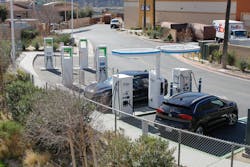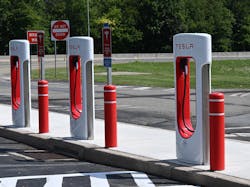Planning for the Future of Electric Vehicles
It’s extraordinary how rapidly the future of electric vehicles is approaching. The pace has been growing so dramatically that it’s hard to anticipate just how quickly the future will arrive. As a result, designers and installers of electric vehicle (EV) charging stations need to be prepared with plans for phased implementation at client sites that can be activated on short notice.
In November 2021, the Infrastructure Investment and Jobs Act (IIJA) earmarked $7.5 billion to build out the first-ever national network of EV chargers in the United States. That investment supports the federal government’s goal that half of all new vehicles sold in the United States will be zero-emissions vehicles (including electric or plug-in hybrids) by 2030. That goal reflects the fact that transportation generates the largest share of greenhouse gas emissions (27% in 2020).
In the wake of that announcement, “Tesla posted a record $3.3 billion profit in the first three months of 2022, with sales of its vehicles up 81% from last year,” according to a recent article in Fortune magazine. “Other carmakers with fledgling EV divisions also saw big sales boosts. Volkswagen Group saw a 65% bump for all of its electric models, while sales of Mercedes EVs were up 37%.”
U.S. consumers seem to have climbed onboard in a big way. “There is a different kind of tipping point that we seem to have hit — an emotional or psychological tipping point among consumers,” said Venkat Srinivasan, director of the Center for Collaborative Energy Storage Science at the U.S. government’s Argonne National Laboratory in Chicago, according to Reuters. He said that “more and more people” would buy EVs “notwithstanding the cost of the battery and the vehicle.”
The EV industry is responding, too. In May, Hyundai announced plans to spend $5.54 billion to build its first dedicated EV and battery manufacturing facilities in the United States.
Thirty-five million EVs are now expected on American roads by 2030. That means another 1.5 million charging ports will be needed, according to NBC News.
With this momentum building so rapidly, designers and installers of EV charging stations must be prepared for whatever pace emerges. Based on all of these factors, planning is needed for the staged implementation of facilities. That planning should have four elements to ensure readiness for whatever transpires.
Element No. 1: Determine the details.
First, consider the nature and needs of each existing property in the context of future EV use. What is the nature of the current parking? Does it serve commuting employees or a commercial fleet? How long is the typical commute or product delivery route? How many existing parking spaces are there? How close are those spaces to the electrical infrastructure?
What needs can be anticipated, beyond a shift to EVs? Will drivers expect to charge their vehicles at work or home? How long will they need to charge them at work? What other charging station options are being planned nearby?
Element No. 2: Assess the extent of the upgrade.
If substantial needs are identified, survey the infrastructure. This will likely require professional engineering assistance, but it will provide the basis for essential future planning.
The existing electrical infrastructure should be evaluated to determine what would be required to adapt it to meet the anticipated needs. Most properties have the existing capacity to serve a small percentage of parking spaces with EV charging. However, how much of an upgrade is needed?
The magnitude and cost of any upgrade to meet anticipated demand will depend on several factors: the capacity of the electrical service upgrade; the distance from existing electrical service to the sites where the chargers will be needed; whether digging trenches is required; and any local law requirements. In New York City, for instance, Local Law 130 requires that any parking garages or parking lots that make electrical modifications must include the electrical capacity needed to make at least 20% of the parking spaces suitable for EVs.
State codes will also affect the magnitude of any upgrade, and those codes may well need to be updated to reflect new and emerging conditions. At present, for instance, codes typically require that designs for EV chargers assume that the charger is drawing at 100% capacity all the time. As patterns of consumer use of EVs evolve, there may well be a need for state codes to be adapted to better reflect those patterns.
The likely need to update state codes may justify doing certain work sooner than later. Work performed before any updating is typically grandfathered into the new standards, so it may be best to perform that work while the existing codes are in place.
It’s also vital to consider how rapidly EVs need to be charged. Chargers on commercial properties would typically be Level 2 chargers that provide around 32 miles of range per hour of charging (Photo 1). If there is a need for Level 3 (industrial) chargers, that will affect both the design and the cost, as generating the more rapid turnaround at Level 3 requires a higher voltage.
It should be noted that there is no reason to think that EVs are more of a fire hazard than fossil fuel-powered vehicles. There is, therefore, no regulatory need for extra fire protection.
Element No. 3: Calculate the cost.
Determine the estimated cost of any needed upgrade. The cost will be influenced by the size of the upgrade and by the siting of the chargers. Will they be scattered across the property or centralized? Will they be spread horizontally or stacked vertically on floors of a multi-story garage? Will the chargers be incentivized by providing prime locations? What structures are needed underneath the chargers to ensure that they cannot be toppled by an errant vehicle?
Fortunately, government and utility incentives can cover 50% or more of the cost, depending on the location and type of property (Photo 2). In New York City, for instance, incentives from the New York State Energy Research and Development Authority (NYSERDA) and local utility Con Edison are significant. Con Edison’s rebate per EV charger port has been as much as $11,200.
There may also be an opportunity for reimbursement for the upfront cost over time through a nominal surcharge beyond the energy consumption of each vehicle serviced. That will depend on the nature of the property and the consumer's willingness to bear that additional cost.
In assessing the cost of needed work, it’s worth considering whether short-term modifications of existing infrastructure are the best approach in the long run. It may be more cost-effective to consider a fuller electrical infrastructure upgrade that offers more benefits over time.
Element No. 4: Execute the plan.
Anticipate and meet the need. Based on the considerations described, develop a staged plan for meeting expected demand: how many chargers and when?
The staged nature of that plan allows not only for adapting to emerging demand but for incorporating new technology that develops. A company called Ample is now building robotic stations that swap in a fully charged EV battery for San Francisco fleet vehicles and Uber drivers in 10 minutes. Each robotic station has a small footprint, equivalent to two parking spots, and, in the company’s words, “An Ample station is 3 to 10 times cheaper than a fast-charging station. It’s cheaper to build and cheaper to install.”
This and other technology may become prominent in the time covered by the plan. As technological innovations continue, the staged plan can be updated accordingly.
The plan can then be activated so that the property is always one step ahead of demand and prepared to meet new developments. It will thus enable “future-proofing” along the way.
Big picture
While these four steps are designed for adapting existing properties to the anticipated demands of growing EV usage, they offer a lens that can be applied in considering the needs of new construction. In that case, there is an immediate question of how much capacity is incorporated from the outset. While one would start with a significant initial capacity, there may still be a need to anticipate and accommodate future growth and innovation. That may yet require a staged approach.
With these four steps, designers and installers of EV infrastructure can ensure that properties are always ahead of the demand for EV chargers.
Daniel Colombini and Vinod Palal are principals at the New York City-based consulting engineering firm Goldman Copeland.
For more articles on the EV charging infrastructure buildout, read through our special compilation of EV content in this recent ebook and special report.
About the Author

Daniel Colombini
Daniel Colombini, P.E., LEED AP, is a Principal and Senior Fire Protection Engineer at Goldman Copeland, the New York City-based consulting engineering firm that has been providing engineering services for more than 50 years to many of Greater New York’s most iconic buildings. In that capacity, he plays a key role in the operations of such renowned institutions as the Empire State Building, Hospital for Special Surgery, The Morgan Library & Museum, New York-Presbyterian Hospital, New York University, Scholastic Inc., Vornado Realty Trust, and several historic Broadway theaters. A licensed professional engineer specializing in fire protection, Dan is a nationally recognized leader, having been named “Engineer of the Year” in 2018 by Plumbing Engineer magazine.

Vinod Palal
Vinod Palal, P.E., is a Principal and Senior Electrical Engineer at Goldman Copeland, the New York City-based consulting engineering firm. In that capacity, he manages multi-disciplinary design projects throughout the Greater New York City tri-state area. His notable projects and clients have included Audible’s headquarters, the City of New York, the Empire State Building, Hackensack Meridian Health, The Morgan Library & Museum, and National Grid. For the City of New York, he has worked with such agencies as the Administration for Children’s Services, Department of Design and Construction, and Department of Sanitation to implement system and building upgrades in existing properties and new construction.


